I had the opportunity to interview Anousha Payne during the 2023 fall, as soon as she returned to London, where she now lives, after a residency at Jana Koya in Landers (CA). I would look at her painted figures on the canvas, or sculpted in clay, they were neither human nor totally animal, and I could not help but think of something fluid and dynamic: something that goes toward another element, profoundly primal, sometimes surreal and fictitious, other times, far away.
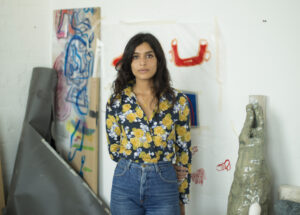
Anousha Payne, portrait. Courtesy the artist
Giulia Pontoriero: How was the experience of Villa Lena residency and how was it to approach that space
Anousha Payne: Villa Lena came to me at a time when I was very much at the beginning of my practice and I was working with ceramics. I was experimenting quite a lot and I was very interested in the idea of fluidity between humans and animals: I used to look at non-human beings and give them human attributes. A lot of my work mainly focuses on folk tales and short stories that deal with human behaviors in relation to the natural world. Now my work has become more focused on fictional and surreal narratives which are past experiences mixed up with fictionality, dreams, and mythology. My time at Villa Lena was important in order to obtain space and time to try out things. In fact, before Villa Lena, I had never worked with cup paintings or stretched canvas and had never really delved into painting as a medium. That period was my way of figuring out what I was going to do with my sculptures, and I am still going through and exploiting this part of the process that has become part of my practice. One of the paintings coming from that period was exhibited in my first solo exhibition “and here she dwells” at Indigo+Madder in London, in 2020.
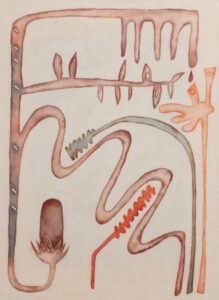
Anousha Payne, “As She Curled Over and Folded Inside, A Droplet Squeezed Out”, 2019. Courtesy Villa Lena Foundation and the artist
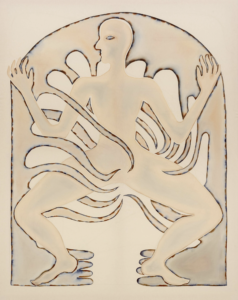
Anousha Payne, “Tangled toes twisted ears”, 2022. Courtesy Public Gallery and the artist
What are the sources you draw from to create your symbolic vocabulary?
In my work, I try to create the new body of a kind of creature that is both familiar and unfamiliar at the same time; as if I am trying to approach the idea of a fluid body or, at least, a non-human world. However, I also think that, because I watched and read a lot of folktales and then started writing my own stories, my formal rendering is a kind of response to these kinds of folktales. Much of the imagery produced by these texts is a kind of projection of an impossible being, something that is half human and half animal. The idea of creating a symbolic image is interesting to me. I am fascinated by images that in a way are indicated as spiritual guides, as I find it intriguing that we can attribute so much meaning or faith to an unknown being.
Is that the reason why you choose to create figures that look like reptiles or snakes?
I think the snake, which I do not really refer to so much nowadays, is part of a phase of my practice from two years ago. The snake was a perfect symbol for me; its texture is so familiar because of its use within fashion objects, bags, shoes, it has almost become over familiar as a texture. I saw this aesthetic motif frequently, and wanted to bring it back to its archetypal form, as a metaphor or symbol for female fertility, as well as power and strength. Moreover, since my sculptures are static, the presence of the snake as the main element gives them a sense of movement or life. The snake is the perfect tool for this, because it is like a piece of skin on a wall: suddenly you have the feeling that something is moving and has life just because of its texture, and I think this is really magical, besides the fact that you can hardly achieve this with other pre-existing materials.
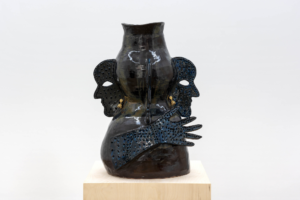
Anousha Payne, “Tangled toes twisted ears”, 2022. Courtesy Public Gallery and the artist
What are the links between ancient traces and your work?
This is a rather difficult question, but I think I am interested in creating symbols that do not look ancient, because when you imagine an ancient symbol or object, you think of something timeless or something you cannot easily get rid of, and I think this is related to a way of creating images. I am instinctively attracted to images that seem ancient because I think they are the most immediate for telling the human. In essence, mine is an investigation into human interaction, how we relate to each other, the Earth, Nature and the materials around us.
What projects are you carrying on at this moment?
I have just exhibited some new works at the India Art Fair (February 2024) and I am about to present my solo exhibition with Sperling in Munich: “A faint glow, a stone and a shark’s tooth”. Regarding this exhibition, I was very influenced by the residency in Joshua Tree, where I collected objects such as stones and rocks and some plants, and then made some metal sculptures with sand castings; from this process a new series of characters was born, which will be shown in my next exhibition in Munich.
Giulia Pontoriero
Info:
Anousha Payne
anoushapayne.com
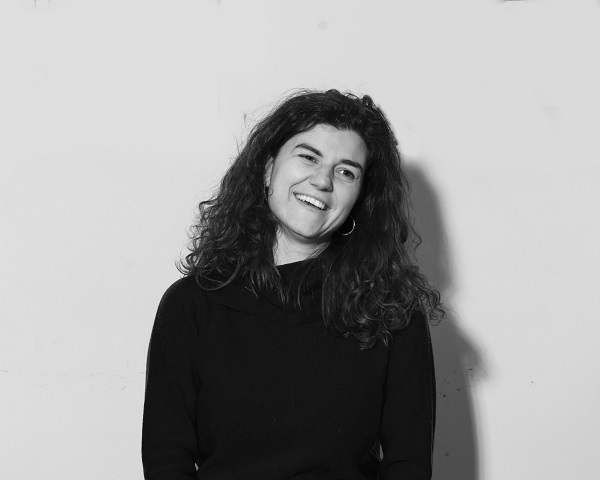
Graduated in Architectural Sciences at the Sapienza University in Rome, with a master’s degree in Contemporary Art and Management at the Luiss Business School, she currently works as an intern and project manager at Untitled Association. Graduated in Photography and Art Criticism in Bologna, she currently carries on her personal projects and is part of the team of the Forme Uniche cultural project.




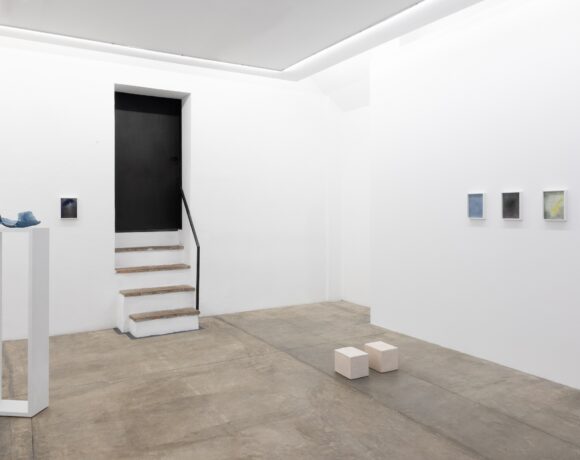

NO COMMENT